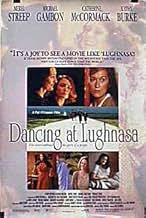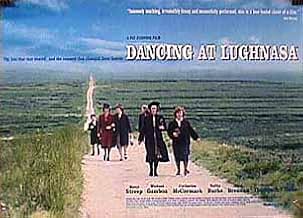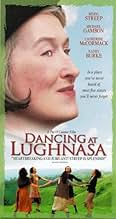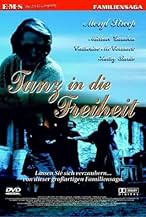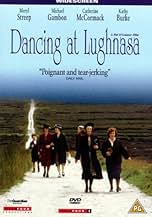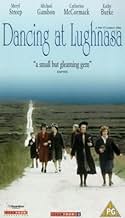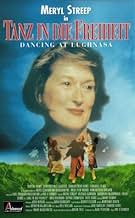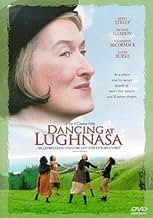IMDb रेटिंग
6.3/10
4.3 हज़ार
आपकी रेटिंग
अपनी भाषा में प्लॉट जोड़ेंFive unmarried sisters make the most of their simple existence in rural Ireland in the 1930s.Five unmarried sisters make the most of their simple existence in rural Ireland in the 1930s.Five unmarried sisters make the most of their simple existence in rural Ireland in the 1930s.
- पुरस्कार
- 2 जीत और कुल 7 नामांकन
फ़ीचर्ड समीक्षाएं
The acclaimed stage play from Brian Friel has been successfully adapted for the screen in this visual treat from Pat O'Connor. The beautiful landscapes of Donegal do not smother the intelligent performances such as from Meryl Streep (Kate Mundy), Catherine McCormack (Christine Mundy) and Rhys Ifans (Gerry Evans). Those critics who have condemned the movie for being simple and about ordinary people seem to miss the point. This is meant to be a simple story about ordinary people - and that is why it is so moving! More importantly though - 'Dancing at Lughnasa' is also entertaining and really deserved better than the mixed reviews on initial release.
... to enjoy this film. I had five Italian aunts and the insights into their sisterly relations appear to me spot on. So often in relationship stories, each character is a paragon of one virtue. Not true in "Dancing in Lughnasa" where the women are not prototypical but rather complex and totally unself-conscious individuals.
As one of the finest actors of her time, to her credit, Meryl Streep doesn't overpower the excellent ensemble cast. Even the men players, who are figuratively essential but literally superfluous to the survivl of this family, are presented as whole people. They are neither villains or heroes; just men. Go figure!
In a film that depends on the actors' considerable restraint in exposing the internal and external dramas of the plot, there are two wonderful moments of abandon near the end: the essential dances of life ... the dance of faith, hope and charity and the dance of decadenced, despair, and destruction.
An overall enjoyable entertainment, the film fails only in not giving the audience a better understanding of the implacable, irreversible outside forces in the world working against the family. This is film after all where we expect to be shown as well as told.
As one of the finest actors of her time, to her credit, Meryl Streep doesn't overpower the excellent ensemble cast. Even the men players, who are figuratively essential but literally superfluous to the survivl of this family, are presented as whole people. They are neither villains or heroes; just men. Go figure!
In a film that depends on the actors' considerable restraint in exposing the internal and external dramas of the plot, there are two wonderful moments of abandon near the end: the essential dances of life ... the dance of faith, hope and charity and the dance of decadenced, despair, and destruction.
An overall enjoyable entertainment, the film fails only in not giving the audience a better understanding of the implacable, irreversible outside forces in the world working against the family. This is film after all where we expect to be shown as well as told.
What distinguishes stage from screen? If a viewer had only Brian Friel's play, `Dancing at Lughnasa' and its cinematic adaptation to judge from, he or she might be tempted to answer that, while stage is highly engaging and meaningful, screen is superficial, insulting, and thin in content. Friel's play is structured in such a way that a film version necessarily provides a fascinating comparison of the two mediums. However, director Pat O'Connor's efforts tend to demonstrate the weaknesses of cinema rather than the strengths. Adapting a play to the screen has often proved to be a tricky business; it involves some pitfalls which this film does not manage to avoid.
Screen is extremely literal. It allows for--in fact, often demands-- a sense of realism seldom conveyed on stage. The makers of `Dancing at Lughnasa' are clearly appreciative of this fact, and have made valiant, if not always successful, allowances for it. The primary result of their efforts is a heightened sense of setting. The world these characters inhabit feels real. We get shot after shot of Irish countryside; set and costume design seem perfect for Ireland in the 1930s. Mark Geraghty's production design is one of the best things about this film. Additionally, excellent accent work by all the actors proves perfectly convincing and adds depth to the setting.
However, such a literal medium has its drawbacks. In particular, young Michael's narration, which was used to achieve a specific effect in the play, seems unnecessary here. The play's Michael is full-grown and speaks young Michael's lines as his `memories' take place in the action on stage. The film makers did well to recognize that there was no cinematic equivalent for this; having the adult narrator speak the child's lines would have seemed ridiculous. However, in removing that aspect of the narrator's role, they stripped away most of his significance, as well. The film's narrator seems like an afterthought, occasionally intruding into the action to tell us that what we are seeing is a memory. We could easily forget that the events are, in fact, happening in flashback.
While some of the abstract elements of Friel's original play do not translate well onto the screen, individual performances are only aided by the medium. Since film is not hindered by the simple vocal requirements of stage, the actors are able to convey much more subtlety of meaning. The players in this film version are, without exception, excellent. Meryl Streep stands out as the proper, reserved Kate. Her manner is nervous and slightly shrill, but conveys genuine concern for her sisters. When Kate opens up and allows herself to dance, Streep shows a joyful abandon which is believable and pleasant to see. Another standout performance is delivered by Michael Gambon in the role of Father Jack. His lines are spoken with calm assurance, betraying Jack's senility only by their complete lack of relevance. Gambon's distant eyes and quiet detachment reinforce the feeling that he exists in a world entirely different from the rest of the family, a point which is absolutely crucial to his character. Supporting characters are also portrayed dead-on. This film has some of the best acting that could have been hoped for.
Despite these considerable advantages, the movie runs into trouble when it tries to adapt Friel's plot to the screen. Film is so much more visual than theater that it demands a great deal of variation in order to keep the viewer interested. Since we do not have the benefit of the actors' physical presence, we need other things to hold our attention. In attempting to add variety to the play's structure, screenwriter Frank McGuinness breaks up Friel's original dialogue into smaller scenes, most of which involve household chores. McGuinness also tries to represent some events which the play's dialogue only alludes to. The result is a film which is so fragmented that we lose sight its content. Friel's dialogue is integrally important to his play, and the same is true for the film. However, the way that the film breaks up this dialogue among tiny scenes is extremely distracting. We lose sight not only of the dialogue's meaning, but of the relationships between characters. Since the adapted structure requires that the five sisters rarely appear in the same scene together, it is very difficult to get any sense of the dynamic in the household. Ultimately, so much time is spent with action rather than dialogue that the characters lose a great deal of their depth. Perhaps film makers did not trust their audience to be as interested in the characters as in the events.
It is somewhat unjust to evaluate an adapted play simply in light of the original. However, this cinematic version fails to hold up even on its own terms. It is difficult to conceive what value those who have not been exposed to the original play could see in this adaptation. What we get is a good-looking, but ultimately insubstantial, portrait of five women who could all stand to let their hair down a little bit more than they do. I can't help but think that Friel had more in mind than demonstrating the value of letting one's hair down.
Screen is extremely literal. It allows for--in fact, often demands-- a sense of realism seldom conveyed on stage. The makers of `Dancing at Lughnasa' are clearly appreciative of this fact, and have made valiant, if not always successful, allowances for it. The primary result of their efforts is a heightened sense of setting. The world these characters inhabit feels real. We get shot after shot of Irish countryside; set and costume design seem perfect for Ireland in the 1930s. Mark Geraghty's production design is one of the best things about this film. Additionally, excellent accent work by all the actors proves perfectly convincing and adds depth to the setting.
However, such a literal medium has its drawbacks. In particular, young Michael's narration, which was used to achieve a specific effect in the play, seems unnecessary here. The play's Michael is full-grown and speaks young Michael's lines as his `memories' take place in the action on stage. The film makers did well to recognize that there was no cinematic equivalent for this; having the adult narrator speak the child's lines would have seemed ridiculous. However, in removing that aspect of the narrator's role, they stripped away most of his significance, as well. The film's narrator seems like an afterthought, occasionally intruding into the action to tell us that what we are seeing is a memory. We could easily forget that the events are, in fact, happening in flashback.
While some of the abstract elements of Friel's original play do not translate well onto the screen, individual performances are only aided by the medium. Since film is not hindered by the simple vocal requirements of stage, the actors are able to convey much more subtlety of meaning. The players in this film version are, without exception, excellent. Meryl Streep stands out as the proper, reserved Kate. Her manner is nervous and slightly shrill, but conveys genuine concern for her sisters. When Kate opens up and allows herself to dance, Streep shows a joyful abandon which is believable and pleasant to see. Another standout performance is delivered by Michael Gambon in the role of Father Jack. His lines are spoken with calm assurance, betraying Jack's senility only by their complete lack of relevance. Gambon's distant eyes and quiet detachment reinforce the feeling that he exists in a world entirely different from the rest of the family, a point which is absolutely crucial to his character. Supporting characters are also portrayed dead-on. This film has some of the best acting that could have been hoped for.
Despite these considerable advantages, the movie runs into trouble when it tries to adapt Friel's plot to the screen. Film is so much more visual than theater that it demands a great deal of variation in order to keep the viewer interested. Since we do not have the benefit of the actors' physical presence, we need other things to hold our attention. In attempting to add variety to the play's structure, screenwriter Frank McGuinness breaks up Friel's original dialogue into smaller scenes, most of which involve household chores. McGuinness also tries to represent some events which the play's dialogue only alludes to. The result is a film which is so fragmented that we lose sight its content. Friel's dialogue is integrally important to his play, and the same is true for the film. However, the way that the film breaks up this dialogue among tiny scenes is extremely distracting. We lose sight not only of the dialogue's meaning, but of the relationships between characters. Since the adapted structure requires that the five sisters rarely appear in the same scene together, it is very difficult to get any sense of the dynamic in the household. Ultimately, so much time is spent with action rather than dialogue that the characters lose a great deal of their depth. Perhaps film makers did not trust their audience to be as interested in the characters as in the events.
It is somewhat unjust to evaluate an adapted play simply in light of the original. However, this cinematic version fails to hold up even on its own terms. It is difficult to conceive what value those who have not been exposed to the original play could see in this adaptation. What we get is a good-looking, but ultimately insubstantial, portrait of five women who could all stand to let their hair down a little bit more than they do. I can't help but think that Friel had more in mind than demonstrating the value of letting one's hair down.
Contemplating suicide? This is just the film for you. It will either put you completely over the top, or convince you that however bad you feel, you might as well live because there are others who are much, much worse off. This is the crushingly sad tale of 5 Irish sisters, each of whom appears to have screwed up any and all chances for personal happiness. Now, stuck together in permanent spinsterhood and extreme poverty, they face economic and personal disaster. Unfortunately, rather than being moved by their plight, I found myself increasingly irritated by their passive reaction to it. Oh yes, if the tragic sisters are not sufficient, there is also the demented, dying brother to cheer things up. Maybe things were really that bad in depression era Ireland. I sincerely hope not. 2 1/2 stars for the scenery and acting.
I wasn't really sure what to expect from this movie, since I had no idea what the play was about or anything. The only actor in the movie I had heard of was Meryl Streep, but that didn't matter because she was the reason I went to see the movie. As always, her accent was pitch perfect, right down to the Donegal vowels. Her performance was also incredible, which deserves some recognition but probably won't get any. The rest of the cast was also wonderful, particularly Sophie Thompson as Rose. If anyone else should get recognition, it should be her because her performance was heart-wrenching and bittersweet. So GO AND SEE IT!!! NOW!!
क्या आपको पता है
- ट्रिवियाOriginal choices to star were Frances McDormand and Kate Winslet.
- गूफ़The radio is one of the first ever made, so it's a tube radio, which would not be able to come on instantly like the later transistor radios; it would have needed a while to warm up before there would be any sound from it.
- भाव
Kate 'Kit' Mundy: I am a righteous bitch, amn't I?
- क्रेज़ी क्रेडिटDuring the opening credits, stills of African tribal dances and of Jack as priest in Africa are shown.
टॉप पसंद
रेटिंग देने के लिए साइन-इन करें और वैयक्तिकृत सुझावों के लिए वॉचलिस्ट करें
- How long is Dancing at Lughnasa?Alexa द्वारा संचालित
- What is 'Dancing at Lughnasa' about?
- Is this film based on a book?
- What is "Lughnasa"?
विवरण
- रिलीज़ की तारीख़
- कंट्री ऑफ़ ओरिजिन
- आधिकारिक साइट
- भाषा
- इस रूप में भी जाना जाता है
- Strange Darling
- फ़िल्माने की जगहें
- उत्पादन कंपनियां
- IMDbPro पर और कंपनी क्रेडिट देखें
बॉक्स ऑफ़िस
- US और कनाडा में सकल
- $22,87,818
- US और कनाडा में पहले सप्ताह में कुल कमाई
- $83,759
- 15 नव॰ 1998
- दुनिया भर में सकल
- $22,87,818
- चलने की अवधि1 घंटा 35 मिनट
- रंग
- ध्वनि मिश्रण
- पक्ष अनुपात
- 1.85 : 1
इस पेज में योगदान दें
किसी बदलाव का सुझाव दें या अनुपलब्ध कॉन्टेंट जोड़ें



